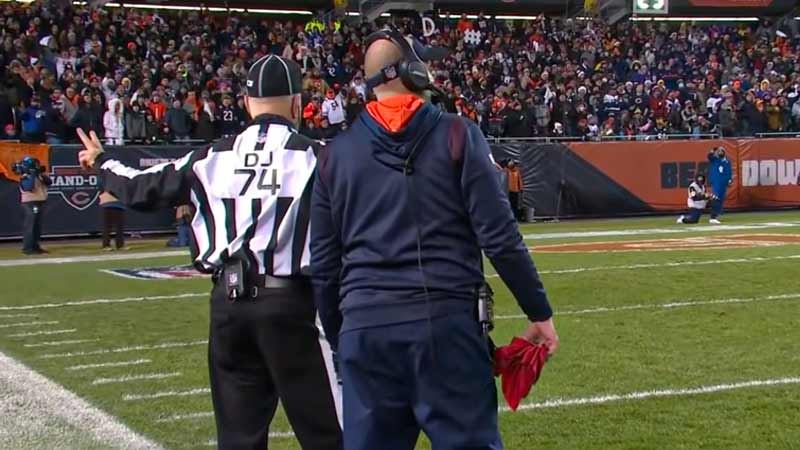In the high-stakes world of American football, where inches can determine victory and defeats can turn fortunes, the Football Challenge Flag stands as a powerful emblem of fairness, accuracy, and strategy.
This unassuming piece of cloth wielded by coaches has revolutionized the game, ushering in an era of transparency, real-time scrutiny, and game-altering decisions.
In this blog post, we delve into the intricacies of the Football Challenge Flag, exploring its significance, rules, and strategic implications. Join us as we uncover the tool that has reshaped the landscape of American football officiating. Stay focused.
What Is Football Challenge Flag?
The Football Challenge Flag is a crucial tool in American football used by coaches to initiate the review of certain on-field decisions made by officials. Each team is allowed a limited number of challenge opportunities per game, typically two.
When a coach disagrees with a call related to issues like player possession, catch validity, or boundary decisions, they can throw the challenge flag onto the field before the next play begins. This signals the officials to halt the game and review the contested call using instant replay technology.
If the review overturns the original call, the challenging team benefits; otherwise, they lose a timeout. The Challenge Flag system aims to ensure fair and accurate officiating in critical game situations.
Football Challenge Flag Rules in NFL
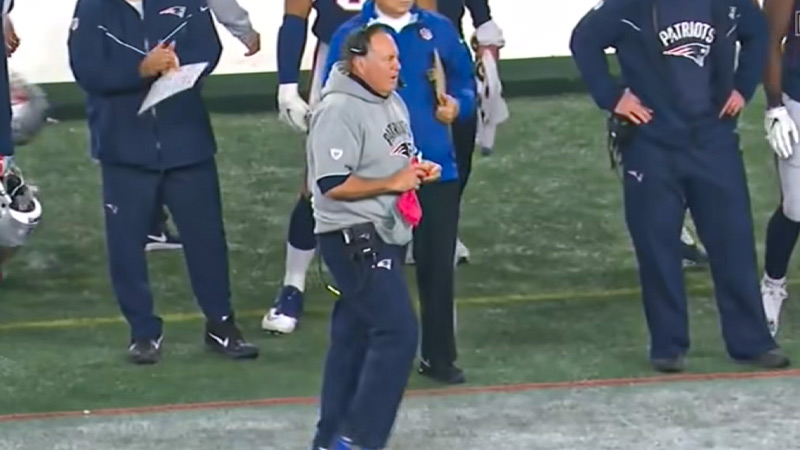
In the National Football League (NFL), the Challenge Flag is a crucial tool for coaches to initiate the review of certain on-field decisions made by officials. Here are the key rules and guidelines regarding the Challenge Flag:
Number of Challenges
Each team is allowed a maximum of two challenge opportunities per game. If a team’s first two challenges are successful, they are awarded a third challenge. However, if the first two challenges are unsuccessful, the team does not receive a third challenge.
Types of Reviewable Calls
Coaches can challenge specific types of calls, such as rulings regarding player possession, catch validity, scoring plays, down-by-contact, and certain boundary decisions. Some calls, like penalties, are generally not challengeable.
Timing and Process
To challenge a call, the head coach must throw the Challenge Flag onto the field of play before the next snap or before the next legal kick. If the ball becomes dead before the flag is thrown, the challenge is not allowed.
Timeouts
When a coach challenges a call, they are essentially “using” one of their team’s timeouts for the challenge process. If the challenge is successful and the call is overturned, the team retains its timeout. However, if the challenge is unsuccessful, the team loses one of its timeouts.
Review Process
- After a challenge is initiated, the game is halted, and the play in question is reviewed by the NFL’s replay officials in the league’s central command center.
- They use various camera angles and technology to make a determination. The call on the field stands unless there is clear and indisputable visual evidence to overturn it.
Challenges in the Final Two Minutes
In the final two minutes of each half (and overtime), challenges must be initiated by the replay officials, rather than the coaches. This prevents strategic time-wasting challenges during crucial moments of the game.
Unsuccessful Challenges
If a coach has no timeouts remaining and their challenge is unsuccessful, their team is penalized 15 yards for delay of game.
Penalty Challenges
Since the 2020 season, coaches have been allowed to challenge certain called or uncalled penalties, such as pass interference.
The Challenge Flag system in the NFL aims to ensure fairness and accuracy in officiating by providing a mechanism for reviewing critical plays.
Plays That Can Be Challenged in American Football
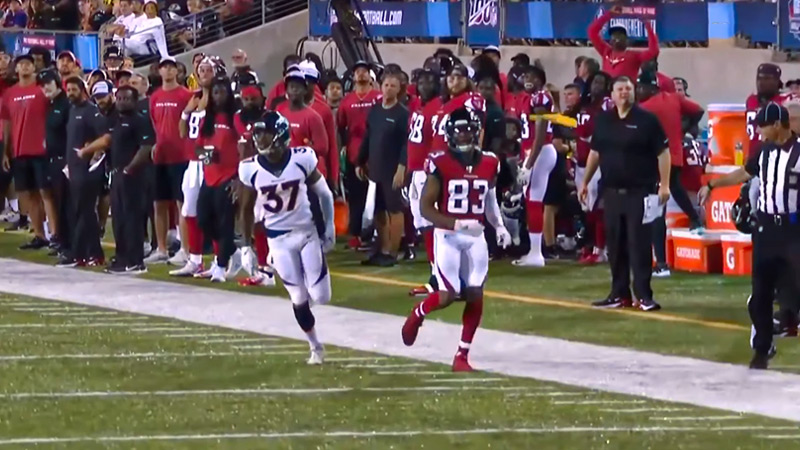
In American football, coaches can challenge specific types of calls related to various aspects of the game. Here are some of the key plays that can be challenged:
Receptions/Catches
Coaches can challenge whether a receiver had possession of the ball and maintained control throughout the process of making a catch, especially when it comes to sideline catches or contested catches.
Fumbles
Challenges can be used to question whether a player lost possession of the ball due to a fumble or if the player was down by contact before the fumble occurred.
Spot of the Ball
Coaches can challenge the spot where the ball is marked by officials, especially in situations where a first down or a touchdown might be determined by a small difference in yardage.
Missed Kicks
Challenges can be used to review whether a field goal or extra point attempt was successful, typically involving the trajectory of the ball over the uprights.
Downed Player
Challenges can be used to dispute whether a player was down by contact or whether they were still in possession of the ball before being ruled down.
Number of Players
Coaches can challenge whether the correct number of players was on the field during a specific play.
Possession of the Ball
Challenges can be used to contest rulings on which team has possession of the ball after a play, especially in situations where there is a scramble for the ball.
Scoring Plays
Challenges can be used to review whether a play resulted in a touchdown, field goal, or safety.
Boundary Decisions
Challenges can be used to question whether a player was in-bounds or out-of-bounds when making a catch or establishing possession.
It’s important to note that not all plays are challengeable, and the rules may evolve over time.
Football Challenge Strategies
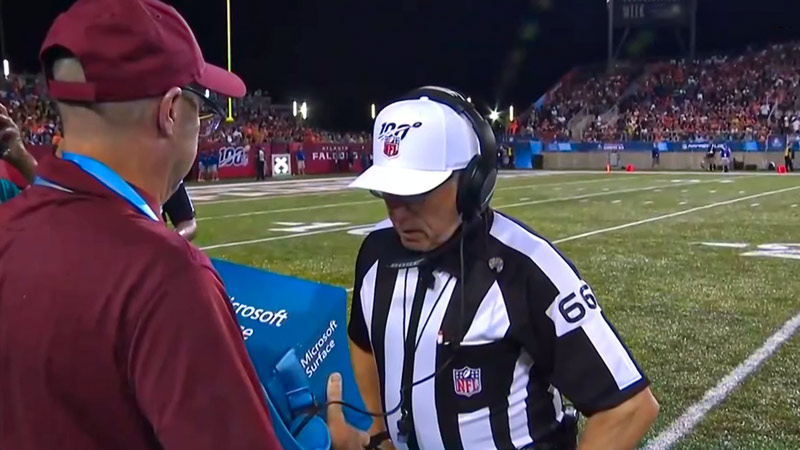
Football challenge strategies involve the tactical use of challenge flags by coaches to maximize their team’s chances of winning by overturning incorrect calls or confirming critical plays. Here are some common challenge strategies:
Critical Situations Only
Coaches often save their challenges for crucial moments when the outcome of a play has a significant impact on the game. This strategy ensures challenges are available for game-changing situations.
High-Impact Plays
Challenges are often used for plays that could result in a turnover, scoring opportunity, or change of possession, such as fumbles, interceptions, or potential touchdowns.
Sideline Catches
Sideline catches are challenging to judge in real time. Coaches might challenge these to determine if a receiver maintained possession with both feet in bounds.
Spot Challenges
Challenging the spot of the ball can be crucial for getting a first down or preventing one. Coaches might challenge when a player’s forward progress appears to be beyond the initial spot.
Two-Minute Warning
In the final two minutes of a half, coaches can’t initiate challenges. However, they can still benefit if the replay officials initiate reviews. Coaches may use timeouts strategically to delay the game and give replay officials time to review critical plays.
Penalty Challenges
If allowed by the rules, coaches might challenge called or uncalled penalties, especially those that directly impact the outcome of a play.
Timeout Management
Coaches need to balance the risk of using challenges with preserving timeouts for other strategic purposes, like clock management and late-game situations.
Information from the Booth
Sometimes, coaches receive input from their booth staff, who might have access to better camera angles and replays. This can influence whether a coach decides to challenge.
Play Clock Management
Coaches must make quick decisions when challenging. Delaying too long might prevent a challenge due to running out of time on the play clock.
Double-Checking Big Plays
Even if a coach is confident in a call, they might challenge to double-check, especially if the play has a huge impact on the game’s momentum.
Conserving Challenges
Coaches need to weigh the importance of the current challenge against the possibility of needing a challenge later in the game. Overusing challenges early might leave them with none for critical moments.
Building Momentum
Successfully overturning a call can energize a team and the crowd. Coaches might strategically challenge to shift momentum in their favor.
These strategies showcase the intricate decision-making involved in using challenge flags effectively.
Penalties for Football Challenge Flag
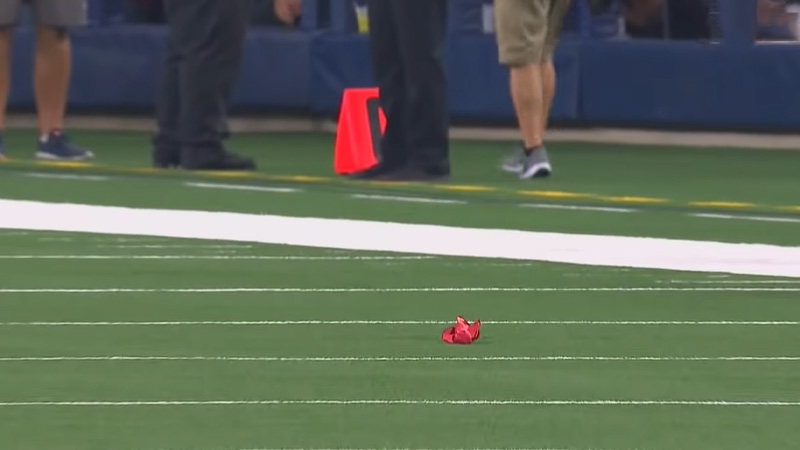
In American football, there are specific penalties associated with the improper use of the challenge flag. If a coach throws the challenge flag inappropriately or challenges a play that is not reviewable, certain penalties may apply. Here are the typical penalties for misuse of the challenge flag:
Delay of Game Penalty
If a coach initiates a challenge when they do not have any challenges remaining or if they challenge a play that is not reviewable, their team may be penalized for delay of the game. This penalty usually results in a loss of 5 yards.
Loss of Timeout
When a coach initiates a challenge, they are essentially using one of their team’s timeouts for the challenge process. If the challenge is unsuccessful and the call on the field stands, the team loses a timeout.
Unsuccessful Challenge Penalty
If a coach initiates a challenge and the call on the field stands (i.e., it is not overturned), their team may be penalized with a loss of timeout, even if they still have timeouts remaining.
Exceptions or changes might be introduced, such as the introduction of challenges for certain penalties, like pass interference, as was the case in recent seasons.
Significance of Football Challenge Flag
The Football Challenge Flag holds significant importance in American football as it plays a crucial role in ensuring fairness, accuracy, and transparency in officiating the game. Here are some key aspects of its significance:
Fairness and Accuracy
The Challenge Flag allows coaches to question and contest on-field decisions made by officials, ensuring that potentially incorrect calls are reviewed and corrected. This promotes a fair and balanced outcome, reducing the impact of human error on the game’s result.
Game-Changing Moments
The Challenge Flag is often employed during critical moments that can greatly influence the game’s outcome, such as turnovers, scoring plays, and boundary decisions. Ensuring accuracy in these high-stakes situations can make or break a team’s chances of winning.
Strategic Element
The limited number of challenge opportunities adds a strategic layer to the game. Coaches must decide when and how to use their challenges wisely, balancing the importance of the call with the risk of losing a timeout.
Transparency and Accountability
The use of replay technology and the Challenge Flag increases transparency in officiating. Fans, players, and coaches can witness the review process, helping to build confidence in the integrity of the game.
Fan Engagement
The Challenge Flag adds an element of suspense and engagement for fans. Watching a challenge unfold and awaiting the review’s outcome can enhance the viewing experience.
Clarification of Close Calls
The Challenge Flag allows officials to take a second look at close calls that are difficult to judge in real-time, such as sideline catches or possession disputes. This leads to more accurate determinations of these intricate plays.
Preventing Blowouts
By potentially reversing incorrect calls, the Challenge Flag can prevent situations where a game becomes one-sided due to a series of erroneous decisions.
Learning Tool
The Challenge Flag and review process help officials learn and improve from their mistakes. It provides an opportunity to analyze and address common officiating errors.
Preserving Integrity
Ensuring accurate outcomes helps preserve the integrity of the sport. The Challenge Flag minimizes controversies and debates arising from disputed calls.
Evolution of the Game
The implementation of technology like the Challenge Flag showcases the NFL’s commitment to adapting and evolving with advancements, making the game more modern and aligned with viewer expectations.
FAQs
What is the Football Challenge Flag and how does it work?
The Football Challenge Flag is a device used by coaches in American football to challenge on-field decisions made by officials.
It involves throwing a flag onto the field before the next play begins, prompting a review of the contested call using instant replay technology. If there’s clear evidence to overturn the original call, it’s changed; otherwise, it stands.
What types of plays can be challenged using the flag?
Coaches can challenge specific types of calls, such as receptions, fumbles, the spot of the ball, missed kicks, downed players, the number of players on the field, and possession of the ball. These challenges focus on critical moments that can significantly impact the game’s outcome.
How many challenges are allowed per team?
Each team is typically allowed two challenge opportunities per game. If both challenges are successful, they receive a third challenge. However, if the first two challenges are unsuccessful, the team doesn’t get a third chance.
What penalties are associated with misusing the Challenge Flag?
Misusing the Challenge Flag can result in penalties such as a delay of game penalty, loss of timeout, or loss of yardage. For instance, challenging a play that isn’t reviewable or using a challenge when no timeouts are available can lead to these penalties.
How does the Challenge Flag impact the game’s strategic aspect?
The Challenge Flag introduces a strategic dimension to the game. Coaches need to decide when and how to use their challenges effectively, considering the importance of the call and the potential risk of losing a timeout. Challenges are often reserved for critical moments to maximize their impact.
Wrapping Up
The Football Challenge Flag transcends its physical form, embodying the ideals of precision and fairness in the dynamic realm of American football.
As technology continues to intertwine with the fabric of the sport, the challenge flag remains a sentinel of accountability, ensuring that every yard gained or lost is determined with utmost accuracy.
Its significance reaches far beyond the sidelines, influencing the rhythm of the game and captivating the hearts of fans worldwide. The Football Challenge Flag is more than a flag; it’s a symbol of the relentless pursuit of accuracy in the quest for victory. Best wishes.

